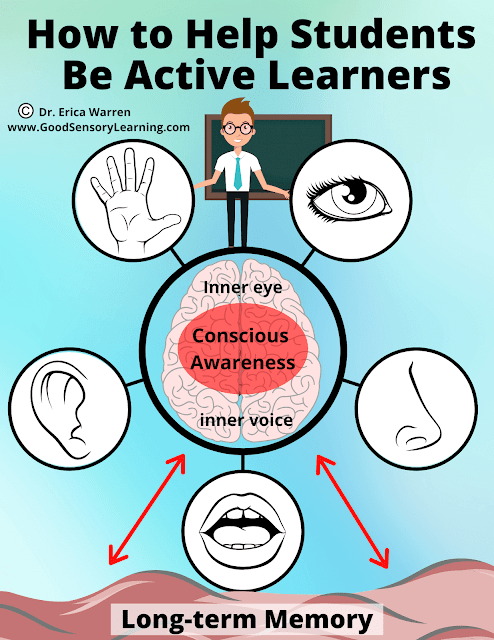This week I wanted to tell you about my online store, Good Sensory Learning. I’m Dr. Erica Warren, and I established this site so I could share all the materials that I have created over the last 20+ years as a learning specialist and educational therapist. When I first began my private practice, Learning to Learn, I had great difficulty finding fun and multisensory materials for my students that were effective and engaging. So back in 2005, I made it my mission to design and distribute high-end, remedial products as well as memorable, motivating lessons that bring delight to learning. If you would like to try a free sampling of my activities , CLICK HERE . How Are the Products Organized at Good Sensory Learning? You can download my Free Printable Catalog or you can browse the site using the grey “search all products” bar in the top right of any page with keywords such as dyslexia, working memory, and executive functioning. What’s more, drop down menus in the red banner allow you t...
Many classrooms nurture passive learning by training students to sit still and receive lessons through lectures and texts. They are expected to acquiesce, listen, absorb, and remember the new content. Unfortunately, this approach does not serve the needs of all students, and an active learning environment can offer an exciting solution.
 At Good Sensory Learning we offer a large selection of multisensory, active lessons for reading, writing, math and even cognitive ways of processing such as visualization. To learn more about these active and engaging products, CLICK HERE.
At Good Sensory Learning we offer a large selection of multisensory, active lessons for reading, writing, math and even cognitive ways of processing such as visualization. To learn more about these active and engaging products, CLICK HERE.
Dr. Erica Warren is the author, illustrator, and publisher of multisensory educational materials at Good Sensory Learning and Dyslexia Materials. She is also the director of Learning to Learn and Learning Specialist Courses.
· Blog: https://learningspecialistmaterials.blogspot.com/
· YouTube Channel: https://www.youtube.com/user/warrenerica1
· Podcast: https://godyslexia.com/
· Store: http://www.Goodsensorylearning.com/ & www.dyslexiamaterials.com
· Courses: http://www.learningspecialistcourses.com/
· Newsletter Sign-up: https://app.convertkit.com/landing_pages/69400
What is Active Learning?
Active learning environments are bustling with energy and thought-provoking activities. Students are busy engaging with others, sharing ideas, and applying new content to prior knowledge. Active learners are continually involved in creative projects, self-directed learning, mindful activities, interactive discussions, and multisensory ways of learning. In addition, learners can discover how to use their inner voice and visualizations to make content memorable and easy to encode.What are Active Learning Strategies for the Classroom?
Active learning strategies involve a different teaching approach as well as engaging lesson ideas. Students are not looked upon as empty vessels that need to be filled. Rather, they come to the table with a wealth of knowledge and interests that can make the learning process both fun and memorable. Some active learning strategies that can be used in the classroom are:- Roleplaying: The teacher divides the class into groups and allows the students to act out historical time periods or famous people.
- Discussions: Classroom discussions involve a sustained exchange of thoughts and ideas with the purpose of developing opinions, understanding concepts, and acquiring skills.
- Hands-on learning: This approach directly involves learners by actively encouraging them to be physically involved with the subject matter.
- Cooperative learning: This strategy encourages small groups of students to work together on a common task.
- Think Pair Share: This cooperative approach allows students to work collectively to solve problems or answer questions. Students learn to:
- think independently
- share ideas with peers
- discuss lessons with a partner
- Learning Games: Learning games are integrated into lessons to offer practice with new learning content. This allows the students to move around and have fun with other peers in small groups.
Where Can I Find Active Lesson Ideas?
 At Good Sensory Learning we offer a large selection of multisensory, active lessons for reading, writing, math and even cognitive ways of processing such as visualization. To learn more about these active and engaging products, CLICK HERE.
At Good Sensory Learning we offer a large selection of multisensory, active lessons for reading, writing, math and even cognitive ways of processing such as visualization. To learn more about these active and engaging products, CLICK HERE.Cheers, Dr. Erica Warren
· Blog: https://learningspecialistmaterials.blogspot.com/
· YouTube Channel: https://www.youtube.com/user/warrenerica1
· Podcast: https://godyslexia.com/
· Store: http://www.Goodsensorylearning.com/ & www.dyslexiamaterials.com
· Courses: http://www.learningspecialistcourses.com/
· Newsletter Sign-up: https://app.convertkit.com/landing_pages/69400



Comments
Post a Comment